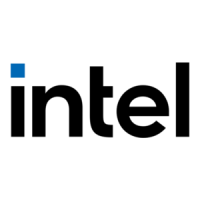
Do you have a question about the Intel Express 10 and is the answer not in the manual?
| Brand | Intel |
|---|---|
| Model | Express 10 |
| Category | Network Router |
| Language | English |
Introduces the switch's features, ports, and SNMP capabilities.
Guides on installing the switch in racks or on shelves, connecting power, and devices.
Explains basic switch operation, auto-detection, and port status LEDs.
Outlines requirements for UTP and fiber optic cabling, including distance limits.
Illustrates pinouts and usage for straight-through and crossover Ethernet cables.
Shows example network setups for mixed speed environments.
Explains network setups using fiber optics for longer distances and multi-floor deployments.
Specifies limitations on the number of repeaters allowed in 10BASE-T and 100BASE-TX networks.
Instructions for connecting to the switch's Console Manager via serial port.
Explains how to interact with the Console Manager interface and enter commands.
Lists categories of commands available in the Console Manager.
Provides an example of a typical Console Manager session and its procedures.
Guides on setting up an IP address for SNMP management of the switch.
Instructions on setting up ports for full-duplex mode for enhanced performance.
Explains how to create Security VLANs (SVLANs) and Virtual Broadcast Domains (VBDs).
Details commands used to monitor network traffic volume and patterns on ports.
Provides guidance on understanding switch port statistics to detect network issues.
Defines various statistical counters and error types reported by the switch.
Lists console commands and their brief descriptions for quick reference.
Details commands related to configuring and managing IP addresses and network settings.
Covers commands for configuring the SNMP agent, community strings, and traps.
Commands for managing the MAC address table, custom filters, and aging settings.
Commands to manage Virtual Broadcast Domains (VBDs) and Security Virtual LANs (SVLANs).
Commands for configuring and monitoring the Spanning Tree protocol for loop prevention.
Commands to display and configure port settings like duplex mode, speed, and flow control.
Commands to display various Ethernet and switching statistics for ports.
Lists basic commands for managing the console session and system prompts.
Commands to display system status, manage self-tests, and reset the switch.
Explains the `ping` command for testing network connectivity to IP devices.
Commands for managing the ARP table, mapping IP to MAC addresses.
Step-by-step guide to identify and resolve common issues with the switch.
Explains flow control behavior and troubleshooting steps for overload situations.
Lists the default settings for system, SNMP, IP, and spanning tree parameters.
Details the type, duplex mode, and flow control settings for ports 1 through 8.
Specifies communication parameters, login name, password, and prompt for the Console Manager.
Lists default spanning tree settings including bridge priority and port configurations.
Provides hardware specifications, buffer size, architecture, and supported MAC addresses.
Lists optional expansion modules and network management software.
Details SNMP and serial console support for network management.
Explains the meaning of status LEDs for each port.
Describes indicators for management activity, power status, and device failure.
Information on NVRAM loading, firmware download, and BOOTP support.
Lists the types of physical connectors available on the switch.
Specifies maximum cable lengths for UTP and fiber optic connections.
Lists the networking standards and RFCs supported by the switch.
Details AC line frequency, fuse ratings, and voltage configurations.
Lists FCC, EN, UL, TUV, CE, and CSA certifications.
Explains the switch's SNMP agent capabilities and supported MIB standards.
Outlines the terms and conditions of the product's hardware warranty.
Details FCC compliance for Class A digital devices and potential interference.
States compliance with EU directives and EMC standards.